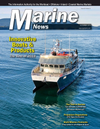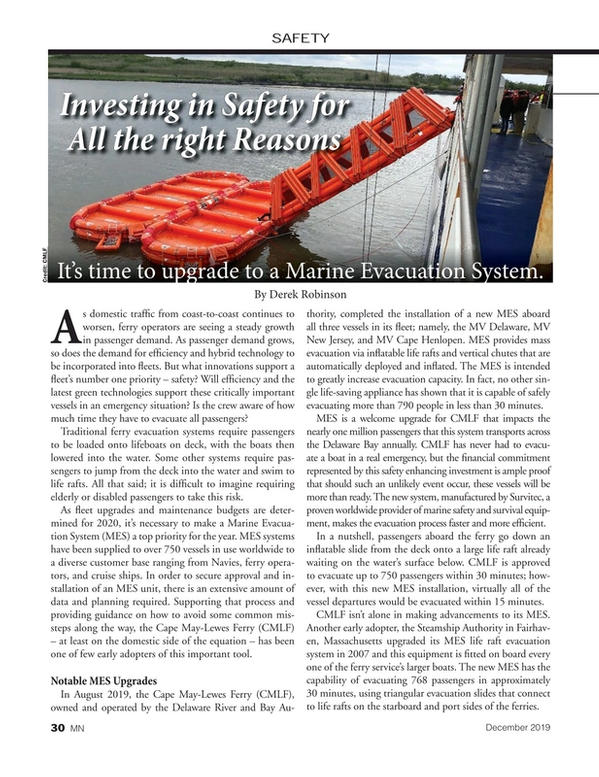
It’s Time to Upgrade to a Marine Evacuation System
As domestic traffic from coast-to-coast continues to worsen, ferry operators are seeing a steady growth in passenger demand. As passenger demand grows, so does the demand for efficiency and hybrid technology to be incorporated into fleets. But what innovations support a fleet’s number one priority – safety? Will efficiency and the latest green technologies support these critically important vessels in an emergency situation? Is the crew aware of how much time they have to evacuate all passengers?
Traditional ferry evacuation systems require passengers to be loaded onto lifeboats on deck, with the boats then lowered into the water. Some other systems require passengers to jump from the deck into the water and swim to life rafts. All that said, it is difficult to imagine requiring elderly or disabled passengers to take this risk.
As fleet upgrades and maintenance budgets are determined for 2020, it’s necessary to make a marine evacuation system (MES) a top priority for the year. MES systems have been supplied to over 750 vessels in use worldwide to a diverse customer base ranging from navies, ferry operators, and cruise ships. In order to secure approval and installation of an MES unit, there is an extensive amount of data and planning required. Supporting that process and providing guidance on how to avoid some common missteps along the way, the Cape May-Lewes Ferry (CMLF) – at least on the domestic side of the equation – has been one of few early adopters of this important tool.
Notable MES Upgrades
In August 2019, the Cape May-Lewes Ferry (CMLF), owned and operated by the Delaware River and Bay Authority, completed the installation of a new MES aboard all three vessels in its fleet; namely, the MV Delaware, MV New Jersey, and MV Cape Henlopen. MES provides mass evacuation via inflatable life rafts and vertical chutes that are automatically deployed and inflated. The MES is intended to greatly increase evacuation capacity. In fact, no other single life-saving appliance has shown that it is capable of safely evacuating more than 790 people in less than 30 minutes.
MES is a welcome upgrade for CMLF that impacts the nearly one million passengers that this system transports across the Delaware Bay annually. CMLF has never had to evacuate a boat in a real emergency, but the financial commitment represented by this safety enhancing investment is ample proof that should such an unlikely event occur, these vessels will be more than ready. The new system, manufactured by Survitec, a proven worldwide provider of marine safety and survival equipment, makes the evacuation process faster and more efficient.
In a nutshell, passengers aboard the ferry go down an inflatable slide from the deck onto a large life raft already waiting on the water’s surface below. CMLF is approved to evacuate up to 750 passengers within 30 minutes; however, with this new MES installation, virtually all of the vessel departures would be evacuated within 15 minutes.
CMLF isn’t alone in making advancements to its MES. Another early adopter, the Steamship Authority in Fairhaven, Massachusetts upgraded its MES life raft evacuation system in 2007 and this equipment is fitted on board every one of the ferry service’s larger boats. The new MES has the capability of evacuating 768 passengers in approximately 30 minutes, using triangular evacuation slides that connect to life rafts on the starboard and port sides of the ferries.
Changing the Tide
The MES system is not required by the United States Coast Guard, but is widely used on European ferries and ships. It’s also no small investment: when all is said and done, MES was an $800,000 project for CMLF, including purchase and installation. The equipment notably has a 15 to 20 year life expectancy. The estimated annual recertification for MES units is roughly four times the cost to certify a fleet of Inflatable Buoyant Apparatus (IBA) liferafts, totaling near $160,000 with crane and shipping costs to the servicing facility.
Once installed, tested and trained, MES must be recertified annually. All marine personnel must be trained in abandon ship procedures and emergency evacuation drills must be held annually as part of in-house training initiatives. Additionally, practice units are a must-have in order to get additional crew exposure and to reduce the need to deploy more than one unit per year. This promotes training while increasing the lives of the actual units as the cold from CO2 weakens the material, reducing the lifespan of the slides and rafts.
It is important to note that servicing the system is no small undertaking. New to the United States markets, finding local servicing agents can be challenging, but as the systems become more common, that challenge will likely be a non-issue. In this case, the CMLF team coordinated with technicians from France, and one from Tahiti (who was in Cape May during a blizzard), to train the local servicing agent through three complete evolutions of installation, deployment, removal, recertification. In November, 2019, the local selected service station completed their final training evaluation.
For more than a century, ferries have relied on lifeboats or life rafts as their primary evacuation system. It’s time to push the ferry industry forward and take it upon ourselves to improve the measures we take on a daily basis to ensure a safe journey for passengers. Not because it will be inexpensive or initially easy, but instead, because it’s the right thing to do. That statement will truly hit home once your team pushes a button, slides down the unit into a waiting IBA that takes less time to deploy than an old life raft ever did.
 Derek Robinson is a Port Captain with the Cape May-Lewes Ferry. Robinson, a lifelong resident of South Jersey, is a graduate of Maine Maritime Academy. Robinson holds an Unlimited Tonnage Inland Master USCG License with First Class Pilotage for the Southern Delaware Bay Region. |
Read It’s Time to Upgrade to a Marine Evacuation System in Pdf, Flash or Html5 edition of December 2019 Marine News
Other stories from December 2019 issue
Content
- INSIGHTS: Niels Aalund page: 14
- Op/Ed: What Good Boats Can Do page: 22
- The Good, the Bad and the Undeniably Ugly page: 24
- The Mighty Mississippi: Taming the Bull page: 26
- Beware of the Nominal Entity page: 28
- It’s Time to Upgrade to a Marine Evacuation System page: 30
- NOx Control: Should Certain Vessels Get a Break? page: 34
- The Top 10 Workboat Stories for 2019 page: 36
- For Fireboats, The Heat is On page: 46


